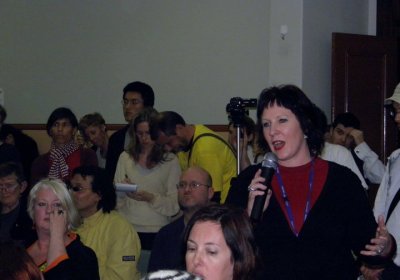About 500 people rallied at City Square against coal seam gas (CSG) extraction in Seaspray on August 17. Many at the rally were cattle farmers in the Gippsland area.
Protesters expressed concern that CSG mining would destroy farmland, contaminate water, threaten the health of their rural community and create seismic activity.
Some farmers expressed their dilemma over whether to stay and fight the CSG companies, or sell their properties before CSG becomes established in the area.
Fracking
This statement was released by the Socialist Alliance on August 16.
***
The Socialist Alliance demands a total ban on fracking. The method of hydraulic fracturing — or fracking — to extract gas from coal seams involves pumping out large quantities of water that can release salt and toxic chemicals into groundwater.
Coal seam gas (CSG) wells have been found to leak methane, which is a major greenhouse gas and has a far higher global warming effect than carbon dioxide.
About 40 people gathered at Reg Hillier House in Darwin’s rural area on August 15 to discuss threats posed by petroleum companies wanting to explore for oil and gas.
Applications for exploration under the Petroleum Act, which could include oil or gas, have reached the outer rural areas including the entire Cox Peninsula, parts of Humpty Doo and Howard Springs, the Dundee area and Litchfield National Park. Exploration may involve using the controversial method of horizontal hydraulic fracturing (“fracking”) if shale gas is found.
A public meeting held in the Tasmanian town of Oatlands on August 2 discussed the application by PetroGas, an offshoot of Petratherm, to explore for shale gas and oil in more than 3000 square kilometres of southern Tasmania.
About 80 residents attended the meeting. Tim Kirkwood, general manager of Southern Midlands council, said it was the best-attended public meeting ever held in Oatlands.
The process of “fracking” for gas requires millions of litres of water and a major concern for many of the farmers present was the question of where the water would come from.
A truck delivering waste from a fracking operation in Greene County, Pennsylvania, on April 19 was quarantined after being rejected by a hazardous waste landfill as too dangerous.
The truck was carrying highly radioactive radium-226 in concentrations 86 times higher than allowed per Environmental Protection Agency limits.
After being quarantined at the landfill, the truck was sent back to the fracking site, which is operated by Rice Energy.
Radium, it should be noted, is a routine by-product of fracking — the fossil fuel extraction method behind the ongoing “natural gas boom”.
The Conservation Council of Western Australia released this statement on May 9.
***
The Conservation Council of Western Australia (CCWA) has warned that the state government could be repeating the mistakes made on James Price Point by rushing into a major new industrial gas fracking project in the Kimberley that risks serious and irreversible damage to the cultural and environmental values of the region.
Dart Energy company executives, accompanied by their minders, were roasted at a 200-strong Town Hall community meeting on August 16 in the inner city suburb of St Peters. Dart is the coal seam gas company with a licence to explore for coal seam gas under the whole of the Sydney basin.
Dart CEO Robbert de Weijer unsuccessfully tried to allay community fears about a number of issues. He argued it was “unlikely” drilling would even happen in St Peters and that the company doesn’t use the controversial fracking (hydraulic fracturing) process or BTEX chemicals (Benzine and similar toxins).
Coal seam gas exploration is becoming a key political issue in NSW. The Labor and Liberal parties are pushing for a huge expansion in gas mining, including coal seam gas.
But farmers, regional communities and city-dwellers are becoming increasingly worried about the health and environmental consequences of the gas rush.
The NSW government recently approved energy company AGL’s bid to drill 90 coal seam gas wells and build a pipeline and processing centre near Gloucester, north of Sydney.
- Previous page
- Page 5






